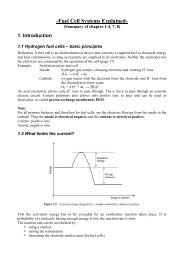Chapter 8. ORGANIC SOLAR CELLS - from and for SET students
Chapter 8. ORGANIC SOLAR CELLS - from and for SET students
Chapter 8. ORGANIC SOLAR CELLS - from and for SET students
Create successful ePaper yourself
Turn your PDF publications into a flip-book with our unique Google optimized e-Paper software.
5.3. IMPORTANT ISSUES IN INCREASING THE EFFICIENCY CHAPTER OF THIN5. FILM THIN<strong>CELLS</strong> FILM <strong>SOLAR</strong> <strong>CELLS</strong><br />
5.3.3 light management<br />
Figure 5.4: T<strong>and</strong>em Cell<br />
Figure 5.5: Multi Junctions<br />
With thin films the absorption path length is too short <strong>for</strong> red <strong>and</strong> blue spectrum. The answer to that is<br />
confinement of photons, which means increasing the absorption path length using light trapping. Now what is<br />
the result of light trapping:<br />
Figure 5.6: Light Confinement<br />
Through an intermediate reflective layer the photons are are trapped in the cell. This layer increases the<br />
photo current in a-Si:H cell <strong>and</strong> thinner films can be processed. It also enhances the stability of the cell. This<br />
is done via scattering at textured interfaces.<br />
Also selective scattering can be used. For red <strong>and</strong> blue scattering one can use Rayleight <strong>and</strong> Mie scattering.<br />
Rayleight scatters blue light with particles ¡¡ then the wavelength <strong>and</strong> Mie scatters particles which are roughly<br />
the same wavelength. R<strong>and</strong>om roughness can be embedded in the FRONT TCO due to deposition process or<br />
wet-etching.<br />
Or to sum up:<br />
23






